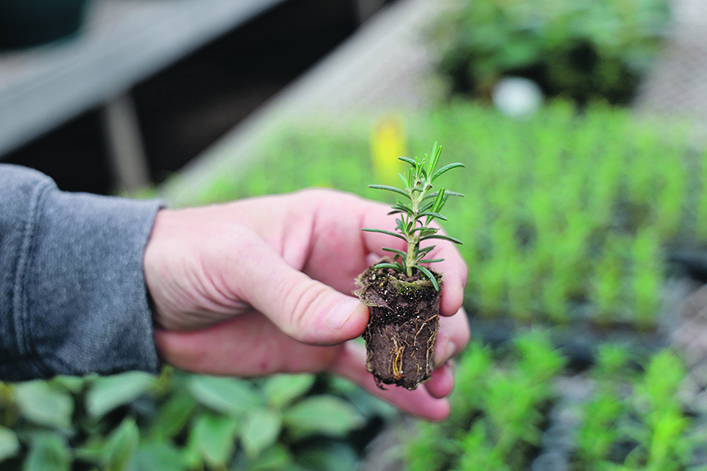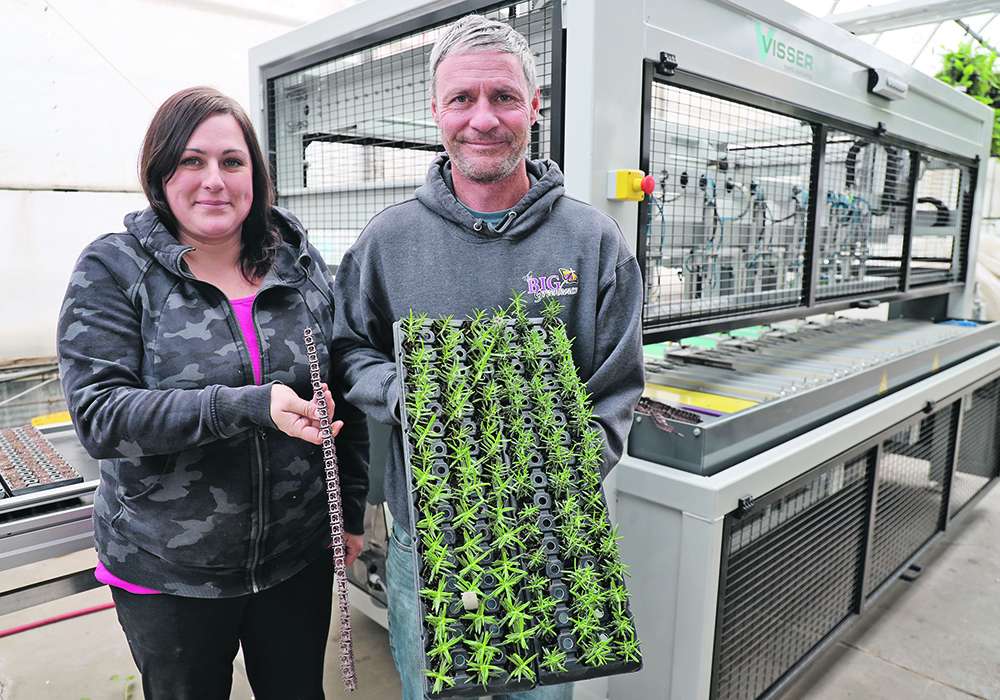Horticultural business adopts a specialized machine that eliminates the drudgery of sticking plants into a soil medium
STURGEON COUNTY, Alta. — Mindy and Justin Bidewell took a step to secure their horticulture future by investing in technology.
One of the most laborious jobs in the greenhouse is to take a tiny plant stem with three tiny leaves and stick it into a soil medium and hope it grows.
“If you were doing this job for four months, it takes a very special person who is able to stick one little stem and three leaves into a piece of soil 100 times on a tray and consistently do that for eight to 10 hours a day,” said Justin of High Q Greenhouses in Sturgeon County.
“I want my staff to enjoy what we want to accomplish. The enjoyable part of the greenhouse business is truly plants, the aspect of sticking a plant is almost impossible.”
Wanting to grow their business and ensure their future, the Bidewells bought a third greenhouse, but also purchased a specialized machine that eliminates the drudgery of sticking plants into a soil medium.
“It allows you the opportunity of growth without having the growth yet. If you have the machine and the efficiency you have the ability to grow.”
“Technology has granted us a great steppingstone. You can catch the efficiency of large facilities while remaining small by technology and automation.”
Knowing he couldn’t hire, or keep staff, to stick thousands of plants needed for the growing business, the family bought an AutoStix machine, a specialized machine that uses sensors and robots to stick, or plant, the tiny stems into equally tiny fibrous pots. The machine can transplant 75,000 to 120,500 plants an hour. It would take a team of 16 employees to accomplish the same feat, but without the pinpoint accuracy of the machine.
“I am wearing my people down every time I add to their workload and try to grow more plants. That is not a winning formula. The winning formula is making sure the process of growing plants is better.”
AutoStix machines are common in very large greenhouses, but are not common in small, family-owned greenhouses. There are three or four AutoStix machines in Canada and High Q Greenhouses owns the only one in Alberta, said Bidewell.
“You have the opportunity to do what you want at the quality and speed you want of a very large facility.”
Not all the plants can be transplanted with the AutoStix. For those, the staff still transplant the plants manually into ellepots, or fibrous, biodegradable pots, by hand. Bidewell’s goal is to have 80 percent of the plants transplanted with the machine.
Increasing the number of plants planted with the machine also depends on the source of the plants. Most plants arriving in the greenhouse are flown in from around the world, mostly from countries bordering the equator.
Within one week of being cut in Africa, Central America or Israel, they are flown to Edmonton and transplanted with the machine and placed on grow tables in the greenhouse.
Just like other traditional agriculture, flower genetics are highly regulated through patents and agreements. Bidewell has contracts with several companies to root and sell their specific varieties of plants under strict rules.

“Every year we have a contract to receive genetic plants, root them and we have different avenues to sell them.”
Bidewell’s agreements allow him to root and sell the plants from the High Q location to other facilities. They supply their other two greenhouses, The Big Greenhouse in Spruce Grove and the Local Nursery near Devon. They are also the supplier to 250 different greenhouses and supply several municipalities across the Prairies.
Many of the flower genetic companies ship Bidewell the tiny stems of new plants already embedded into tiny plastic clips ready to put through the AutoStix. The clips are linked together in a long strip about the length of an arm and slide into the machine. Dozens of sensors and robotic arms place the plants into the tiny pots filled with soil. The plants are inserted into the soil with precision and are perfectly straight.
“It is all mechanically designed to plant it for us and be 100 percent accurate.”
Accuracy and staff morale were important considerations when the couple bought the AutoStix machine, but so was the need to control the cost of transplanting into the future.
“This machine allows me to sleep at night knowing in the next 10 years you will never have to hire more manual stickers, if I can remove that burden from the business and freeze that cost.”















